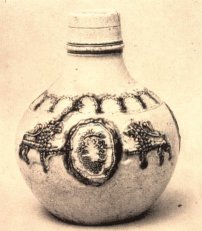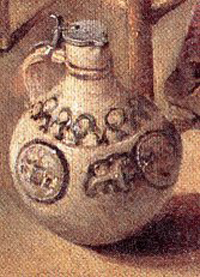Stoneware
 Follow the Lions
Follow the Lions
Generally the identification of an archaeological specimen follows a logical progression of careful searching through the literature to look for parallels. Sometimes serendipity enters in when the study of one object leads to the identification of other similar objects. It almost seems on occasion that when one identifies something as new and unique one suddenly starts recognizing it everywhere. So it was when we “followed the lions.”.
 In the late 1980s a fragment of Rhenish stoneware decorated in blue was found on the shore not far from where the Maryland Dove is moored. The decoration is in the form of two lions rampant flanking an armorial crest. Subsequent study suggests that this crest was that of a Roman Catholic cardinal. Further study of the sherd allowed us to decipher a date of 1646.
In the late 1980s a fragment of Rhenish stoneware decorated in blue was found on the shore not far from where the Maryland Dove is moored. The decoration is in the form of two lions rampant flanking an armorial crest. Subsequent study suggests that this crest was that of a Roman Catholic cardinal. Further study of the sherd allowed us to decipher a date of 1646.
A quick search through a standard source on Rhenish stonewares came up with a very convincing parallel in the form of a complete jug with the date 1648. The central medallion crest is different than our specimen but the style and execution is quite similar.
Subsequent examination of additional fragments of Rhenish stoneware in the collection has led to the identification of other specimens, which have the same flanking lion motif. Many of these specimens are quite small and are only identifiable because we have seen the complete decoration on the large fragment
 Finally, while developing the installation of an exhibit that featured artifacts from both St. Mary’s City and Jamestown, Virginia, we decided to include a reproduction of a Dutch genre painting included as part of a display on ordinaries in early Maryland. This picture, entitled “The Bar Room” was painted in 1665 and depicts the interior of a 17th century tavern. Sitting on the floor was the very jug we were finding fragments of in St. Mary’s City.
Finally, while developing the installation of an exhibit that featured artifacts from both St. Mary’s City and Jamestown, Virginia, we decided to include a reproduction of a Dutch genre painting included as part of a display on ordinaries in early Maryland. This picture, entitled “The Bar Room” was painted in 1665 and depicts the interior of a 17th century tavern. Sitting on the floor was the very jug we were finding fragments of in St. Mary’s City.



